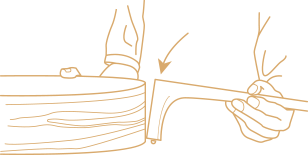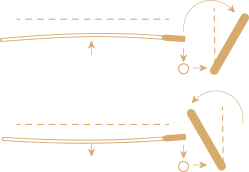Features

Select Pressure Tested Solid Tops
A guitar produces sound as a result of the vibration of its strings. What's not so obvious is the role that the guitar top plays in amplifying these vibrations. In fact, the vibration of the top is one of the most important factors in a guitar's sound. Solid top guitars offer richer sound and wider dynamic range. All Seagull guitars are made with select pressure tested solid tops. Each solid top is pressure tested to ensure its highest level of rigidity and stiffness along with maximum harmonic vibration. This benefits the overall tone, projection and resonance which in turn benefits the player and increases the lifespan of the guitar. The tight, straight grain in this wood produces a unique combination of strength and flexibility. The top is strong enough—in the direction of the grain—to withstand the pull of the strings, while at the same time it's flexible enough—across the grain—to vibrate freely.

The Compound Curved Top
The guitar top is the part of the instrument that most affects the sound. Slightly arching the top above the sound hole resists downward pressure created by the fingerboard and increases the structural integrity of the top and allows for the use of a thinner and more lightly braced top. The compound curve top produces excellent stability in the upper part of the guitar top and the power & projection made possible by leaving the top flat below the sound hole. This area around the bridge is the most active part of the top in regards to vibration.

Sitka Spruce Bracing
The bracing for the new Seagull guitars is quarter-sawn Sitka spruce, scalloped and carved to conform exactly to the curvature of the tops. The strength and lightweight qualities of Sitka Spruce make for ideal bracing material. It provides the strength needed to resist string tension without weighing down the top, allowing it to be more responsive and vibrate freely.

Cedar Or Spruce Top?
Both Cedar and Spruce share the same virtues in terms of better sound and the ability to age. Cedar tends to produce a warmer sound and ages faster than spruce. Spruce is brighter and ages moreover a longer period of time. Visually, cedar is darker in color with a fairly tight grain pattern. Spruce tends to be very blond with a slightly wider grain pattern.

Aging
A solid top vibrates much more freely than a laminated top. This results in richer tone, better dynamic range and better balance of tone. Not only does a solid top sound better initially, over time the vibrations from playing the guitar result in the top vibrating more and more freely. This phenomenon is called 'aging' which means that the more the guitar is played, the better the guitar will sound. It is important to remember in order for a guitar to age it must be played. A guitar left in its case for 5 years will get older, but it will not 'age'.

Bookmatched
A top starts as a single piece of wood, which is sliced open—like a book—and then glued together. This technique is called 'bookmatching' and results in an even grain pattern across the top of the guitar.

Custom Polished Finish
The Custom Polished finish is aesthetically the most beautiful acoustic finish the company has ever produced. The resistance to the common wear and tear of guitar playing that is provided by this finish is applied without sacrificing the incredible sound of these instruments. Unlike “thick” polyester finishes which deaden the natural sound of a solid top, the Custom Polished finish allows the top to breathe and vibrate freely bringing out the true tone of the wood. This in turn promotes the ever important "aging" process, in which the guitar will actually sound better the more it is played over time. Buffed and sanded between each coat, the unparalleled beauty of the Custom Polished finish is reminiscent of the traditional French polish of the 19th century. This finish gives the semi-gloss a gorgeous satin sheen and the high-gloss a lustrous shine as well as accentuating the natural wood grain of the instrument.

Neck Pitch
In order to enjoy all of the advantages of a well-crafted neck, a great deal of care must be given when joining it to the guitar body. The angle of a guitar’s neck attachment—often called 'neck pitch'—plays a crucial role in the instrument’s tone. Simply put; if the neck is too far back the guitar will lose its bass and sound tinny. If the neck angle is too far forward, the guitar will lose its high frequency response and sound muddy. The Seagull neck attachment system insures consistent neck pitch. It also produces the added advantage of a superior neck/body energy transfer because the neck is attached to the body with a clean wood-to-wood connection. There is no glue to impede the vibration between the heel of the neck and the guitar's body.

Double Function Truss System
Most guitars employ an adjustable metal rod inside the neck called a truss rod. The truss rod is typically used to straighten the neck when it becomes slightly bowed from string tension and changes in humidity. In the event of a neck becoming back-bowed the traditional fix is to loosen the truss rod and allow the string tension to pull the neck back to its ideal form. Unfortunately this doesn’t always work which is why we adapted a Double Function truss rod in Seagull necks. The rod bends in both directions, which provides unprecedented control over the neck whether it is under-bowed or over-bowed.

The Seagull Integrated Set Neck
Comfort, sound, and stability, are the three key ingredients that we want in a guitar neck. The Integrated Set Neck system allows for more consistent and stable action while significantly reducing warping and twisting of the neck, largely attributed to changes in climate.

Compensated Seagull Saddle
Seagull guitars feature Tusq nuts and saddles by Graphtech. The fully compensated saddle helps Seagull guitars to play beautifully in-tune all over the neck.

The heel
Did you ever notice that a guitar that sounds perfectly in tune needs to be re-tuned slightly when passed from one player to another? This has to do with the fact that different players place varying amounts of weight and pressure on the neck and this affects tuning. Years ago we discovered that this problem could be alleviated by inserting maple dowels through the heel of the neck. This reinforcement makes the neck several times stronger.

Reverse Headstock
Each Seagull neck starts out as a single piece of Mahogany or Silver Leaf Maple. The wood is cut at a 45 degree angle after which the top piece - the Headstock - is glued back on with the grain reversed. This is an essential step in the Seagull process for creating incredibly stable necks.

Tapered Headstock - Tuning Made Easy
The tapered headstock on Seagull guitars provides straight string pull, which minimizes the neck twisting effect. This insures that it will be easier to get your guitar in tune and keep it that way. This is particularly advantageous for the growing ranks of players who use open tunings.


